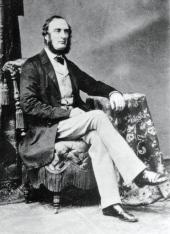
John Palliser, an aristocrat who served in the British army, first explored the North American west in 1847 and 1848 when he travelled from Louisiana to modern-day Montana. In 1856 he began securing sponsorship for a second expedition in what is today western Canada. His funding (and much of his instruction) came from the Royal Geographical Society, the British Colonial Office, and the Hudson's Bay Company. Palliser's expedition left Britain in 1857 and travelled first through the USA before entering Canada at Sault Ste. Marie. His company consisted of James Hector, a geologist and physician; Eugène Bourgeau, a botanist; and John Sullivan, an astronomer. Thomas Blakiston, the magnetical observer, followed a different route via Hudson Bay and met up with the expedition at Fort Carleton, near present-day Saskatoon.
During 1857 and 1858, the party travelled over what is today Saskatchewan, cataloguing the local flora, fauna, and minerals. They also mapped three distinct regions: thick wood country with many lakes in the far north; arid plains in the south; and partially wooded country in between. Palliser speculated that the valleys and partially wooded areas would be suitable for settlements. However, he also identified a large region in present-day southwest Saskatchewan and southeast Alberta rendered unsuitable by lack of rainfall and timber. This region is now known as the Palliser Triangle. In 1858 and 1859, Palliser's expedition travelled in the Rocky Mountains seeking passes to the Pacific Ocean. He returned to England in June 1860, and his general report was delivered to the British Colonial Office in April 1862 at the height of the American Civil War. For this reason, some historians assert the report received only muted attention.
The Hind expedition was formally named the Canadian Red River, Assiniboine and Saskatchewan Exploring Expedition; it was directed and funded by the Province of Canada and led by Henry Youle Hind, an English-born geologist and instructor at Trinity College in Toronto. The expedition departed from Toronto in 1857 with Hind and three other principals: George Gladman, a former fur trader; Simon Dawson, a surveyor; and W.H.E. Napier, an engineer. Their mission was to find a reliable route from Lake Superior to the Red River Settlement, and then to inspect the potential of the land west of Red River for its fitness for future settlement. In 1857 the party journeyed from Lake Superior to Fort Garry and mapped the area; in June 1858 it left Fort Garry and spent three months exploring what is today southern Manitoba and Saskatchewan. One of the expedition members, Humphrey Lloyd Hime, took the first photographs in Saskatchewan. Hind's preliminary report to the Legislative Assembly of Upper Canada was published in 1859; his later narrative book with maps and artwork was published in 1860. Like Palliser, Hind identified the river valleys as the best place for future settlement. Not surprisingly, Hind's writings were relied upon in later years to bolster aspirations of expansion westward into Rupert's Land. Although Palliser and Hind were not the first Europeans to cross Saskatchewan, their expeditions were far more scientific and well-recorded than those of previous explorers.
Gerald Heinrichs